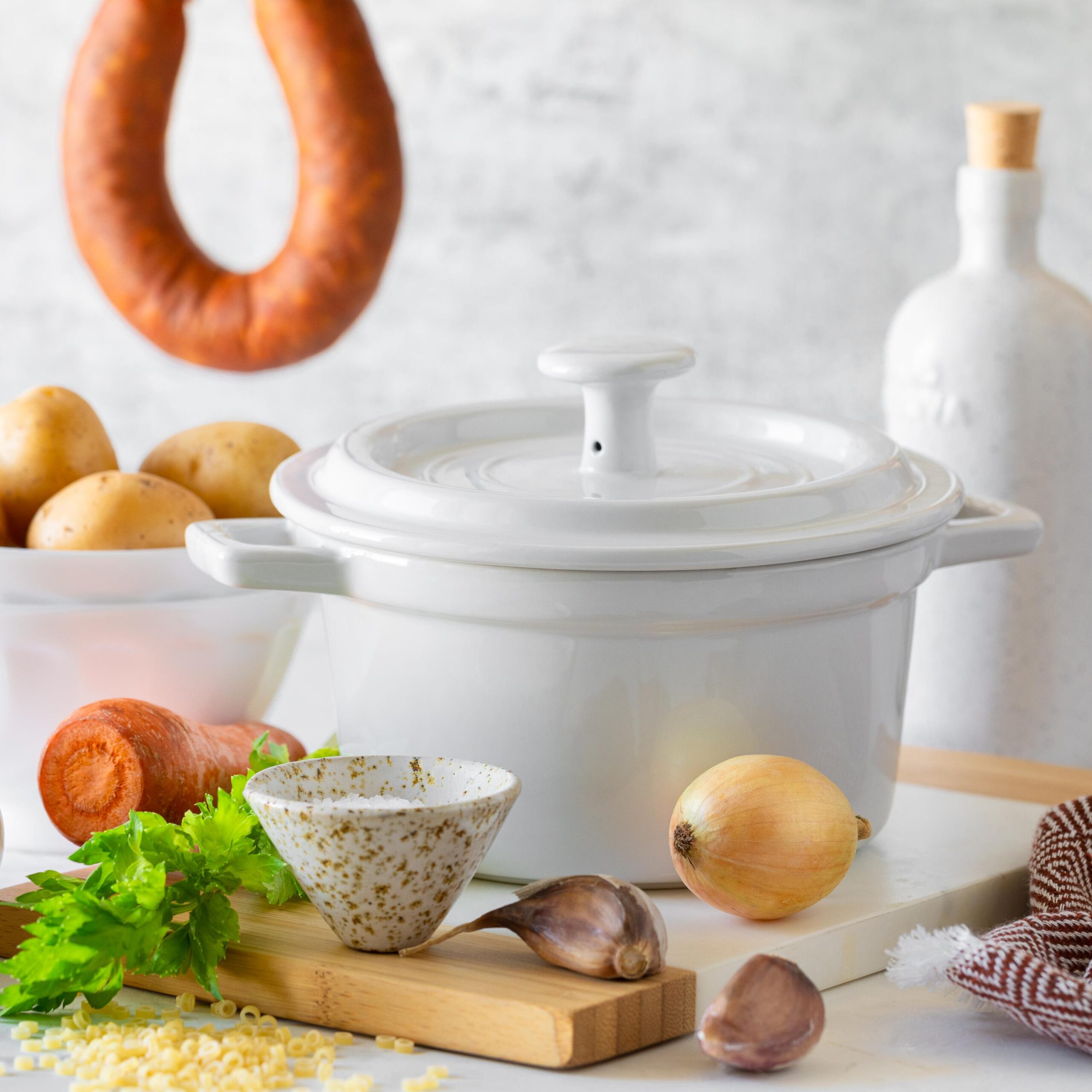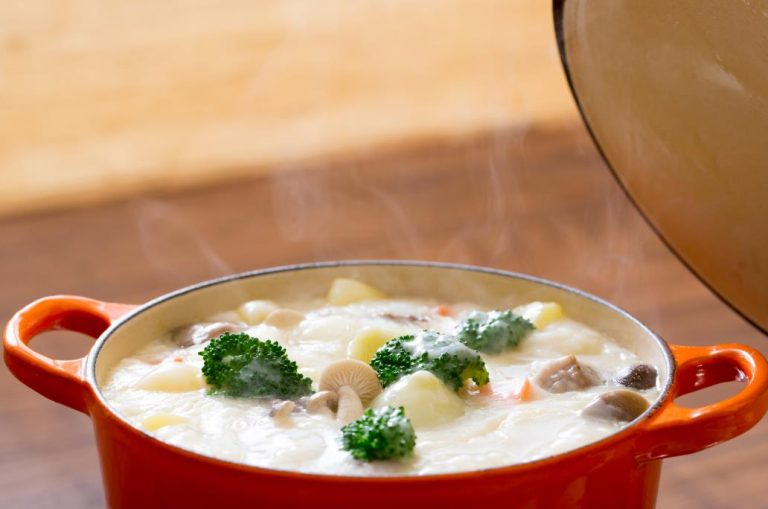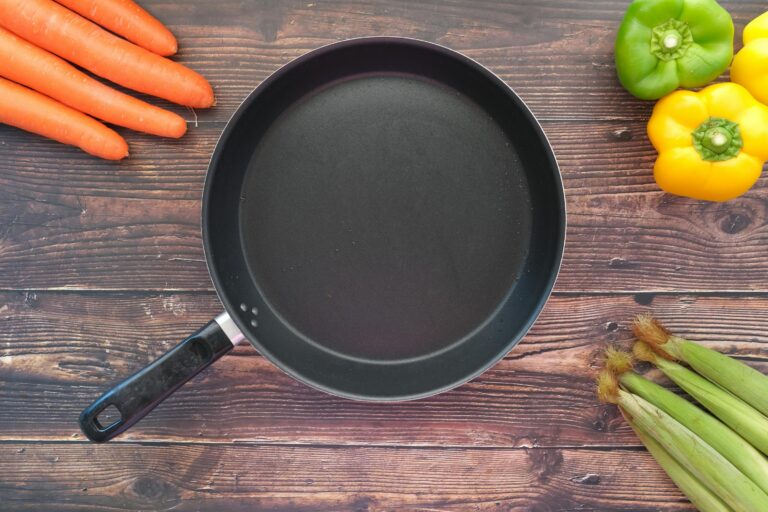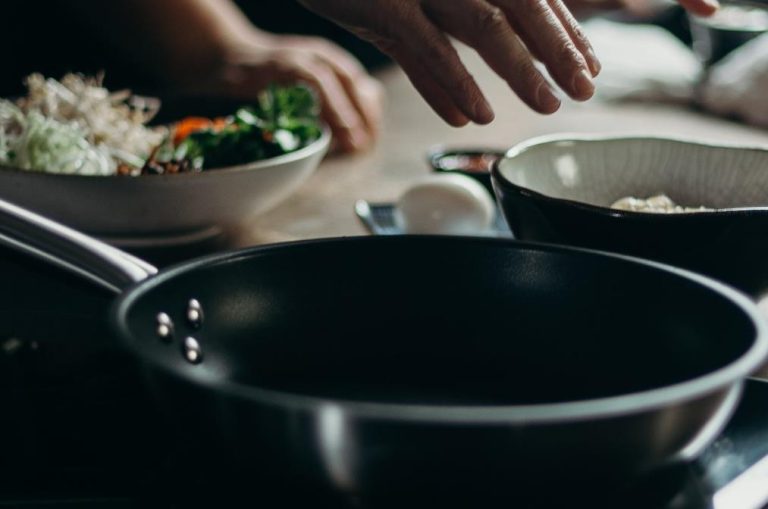Ceramic cookware has soared in popularity for its sleek design and non-stick benefits—but many home cooks wonder: Is it really safe? As more people choose ceramic pots and pans, questions about toxins, safe materials, and actual risks have grown common. If you want to offer customers cookware that’s healthy, reliable, and easy to use at home, these concerns matter.
Ceramic cookware is generally safe when choosing high-quality brands and avoiding damaged or chipped surfaces. While poor-quality products may raise fears of heavy metal leaching (like lead or cadmium), most reputable brands follow strict safety standards to protect food. Newer ceramic-coated options are even safer than traditional Teflon non-stick pans, per Prudent Reviews and The Filtery.
This guide will cover what makes ceramic cookware safe or risky, how it compares to other materials, and how to help customers use and care for it properly.
What Is Ceramic Cookware?
Ceramic cookware comes in two main types: pure ceramic and ceramic-coated cookware. Both are popular in modern kitchens, but they differ in material, construction, and use.
Pure Ceramic Cookware
Pure ceramic cookware is made from natural clay. Manufacturers fire it at temperatures above 1900°F (about 1038°C). These pots and pans often have colorful glazes. The glazes create a smooth, hard surface that can resist stains and odors.
Ceramic-Coated Cookware
By comparison, ceramic-coated cookware has a metal base, such as aluminum or stainless steel, covered with a non-stick layer made from silicon dioxide—a material derived from sand. This technique is called a sol-gel ceramic coating. The process helps to create a slick surface that reduces food sticking and makes cleaning easier.
| Type | Main Material | Common Use | Heat Tolerance |
| Pure Ceramic | Clay | Slow-cooking, baking | Up to 600°F (315°C) |
| Ceramic-Coated | Aluminum/Steel + Silicone Dioxide | Stir-frying, sautéing | 450–500°F (232–260°C) |
Now that you understand what ceramic cookware is, let’s dig deeper into what makes it a safe choice—starting with the chemicals you don’t want in your cookware. When comparing cookware safety, terms like PFAS, PTFE, and PFOA often come up. These chemicals are common in other types of cookware, and understanding them will help you see why ceramic stands out.
Key Chemical Terms to Know: PFAS, PTFE, and PFOA
When stocking your kitchen, few decisions matter more than choosing safe cookware. With so many options on the market—from non-stick pans to stainless steel and ceramic—navigating which materials are truly harmless can feel overwhelming. One question we hear often: Is ceramic cookware safe? To answer that, let’s first clear up some confusion around chemicals commonly linked to other cookware types.
You’ve likely seen these acronyms in discussions about cookware safety. Here’s what they mean in simple terms:
- PFAS (per- and polyfluoroalkyl substances): A group of “forever chemicals” used for their water- and oil-resistant properties. They don’t break down easily and may build up in the body over time.
- PTFE (polytetrafluoroethylene): The synthetic plastic in brands like Teflon, which gives pans their non-stick surface. It’s generally safe at normal cooking temperatures but raises concerns when overheated.
- PFOA (perfluorooctanoic acid): A chemical once used to make PTFE. It’s highly persistent and linked to health risks, though most countries now restrict its use.
So, Is Ceramic Cookware Safe?
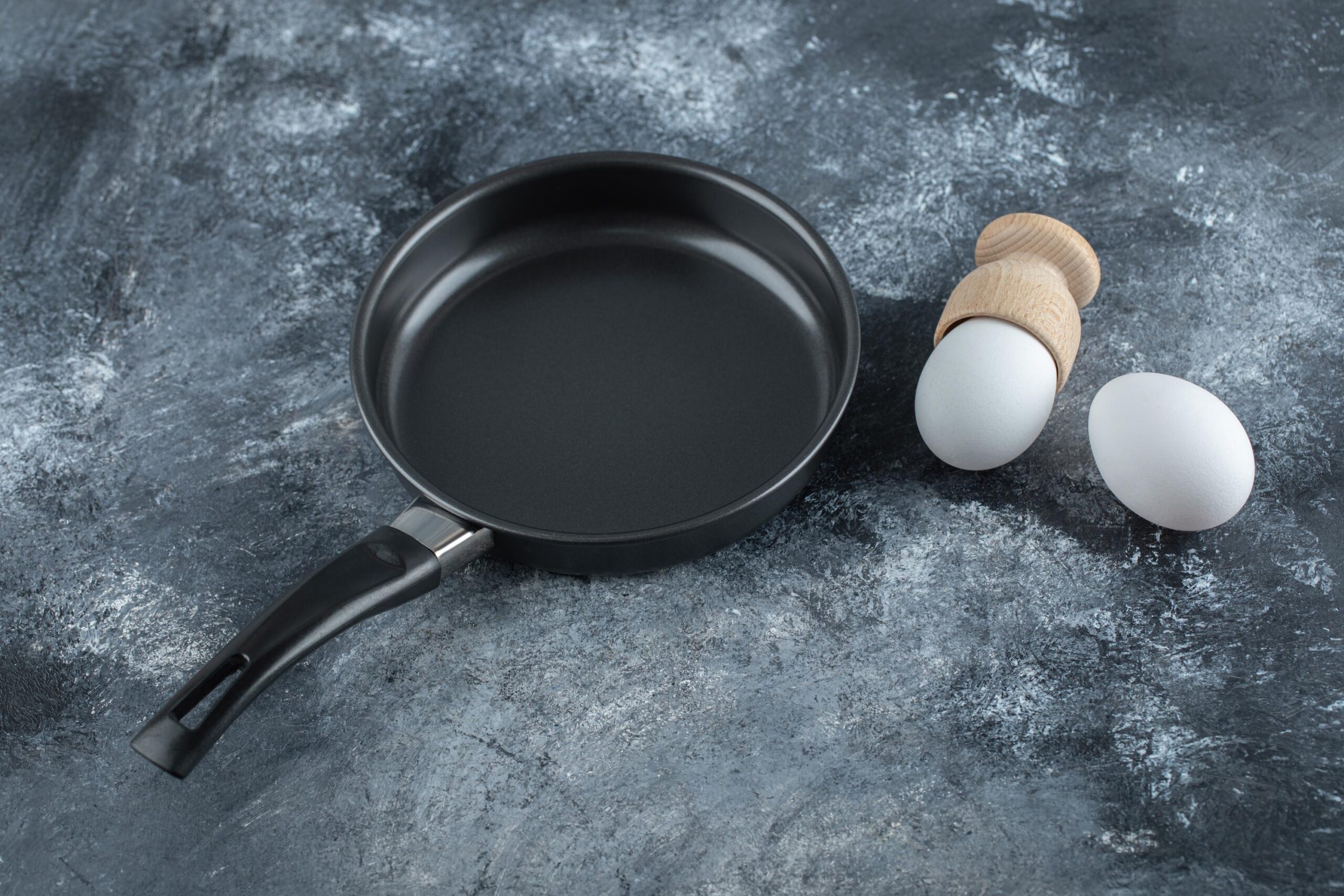
Ceramic cookware can be a safe, non-toxic choice for your kitchen—when chosen carefully. Let’s break down the key safety factors:
What Makes High-Quality Ceramic Cookware Safe?
High-quality ceramic cookware, certified by organizations like the FDA and LFGB, is free from harmful chemicals. Here’s why:
- No toxic chemicals: Reputable brands avoid PFOA, PFAS, PTFE (Teflon), BPA, lead, and cadmium.
- Rigorous testing: Certifications ensure coatings don’t leach chemicals into food, even when exposed to acidic ingredients (like tomatoes or citrus) or high heat. For example:
- The FDA limits allowable lead leaching to <0.5 micrograms per liter of food.
- The LFGB (a stricter European standard) limits heavy metal migration to <0.01mg/kg—far stricter than the FDA.
Non-reactive surface: Ceramic doesn’t interact with food, so it won’t alter flavors or release metals into meals.
Buy Wholesale Knives and Start Scaling up with Us Today
Contact us and connect with a sales rep to get a free quote.
Potential Risks to Watch For
Low-quality or uncertified ceramic cookware may pose risks:
- Heavy metal leaching: Cheap glazes (common in uncertified pure ceramic) may contain lead or cadmium, which can leach into food—especially when scratched or used with acidic ingredients.
- Coating breakdown: Poorly applied ceramic coatings can chip or peel, exposing the metal base (e.g., aluminum) and allowing minor leaching.
- Overheating damage: Ceramic coatings can degrade above 500°F (260°C), releasing faint fumes in extreme cases.
Is Ceramic Cookware Safe After Scratching?
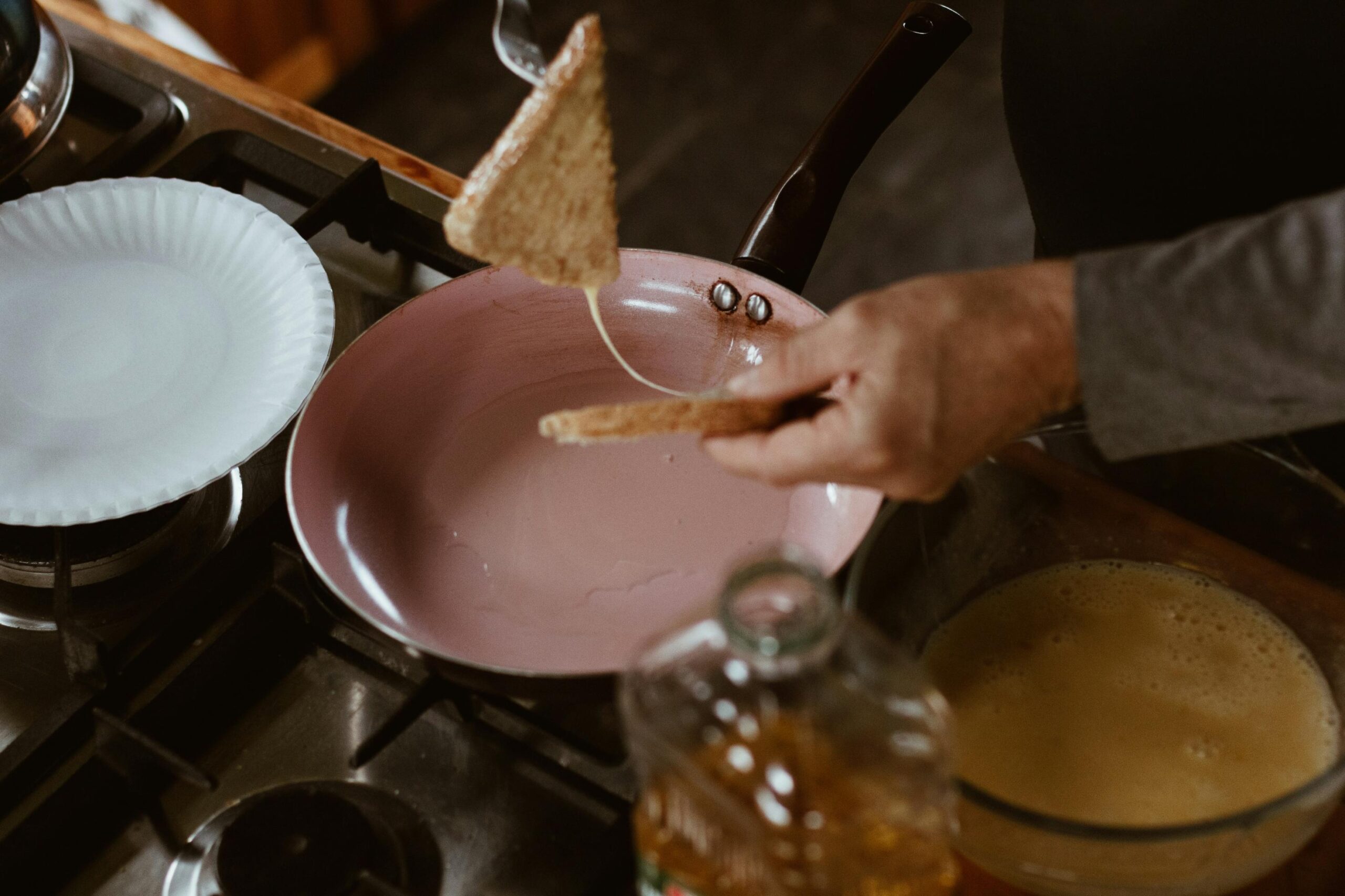
Minor scratches are unlikely to make ceramic cookware toxic, but deep chips can expose the metal base. If the coating is severely damaged:
- Replace the pan if you notice exposed metal (to avoid aluminum or steel leaching).
For minor scratches, avoid acidic foods and replace the pan soon to prevent further wear.
How Does Ceramic Cookware Compare to Other Types?
Ceramic cookware stands out for its non-toxic, non-stick properties, but how does it stack up against alternatives?
Here’s a quick comparison:
| Type | Non-Stick? | Chemicals Used | Scratch Risk | Heat Tolerance | Best For |
| Ceramic | Yes | No PFAS, PFOA, PTFE | High | 450–600°F | Low-oil cooking, acidic foods |
| Teflon (PTFE) | Yes | PTFE; some old models have PFAS | Medium | <500°F | Quick, low-heat cooking |
| Stainless Steel | No | None (but may leach nickel/chromium if scratched) | Low | Up to 600°F | High-heat searing, durability |
| Cast Iron | No (unless seasoned) | None | Low | Up to 1,500°F | Oven cooking, long-term use |
| Aluminum | Sometimes | Bare aluminum leaches; coated versions may use PTFE | Medium | 400–500°F | Lightweight, fast heating |
Key takeaway: Ceramic avoids the toxic chemicals of Teflon and is gentler on acidic foods than stainless steel or aluminum. However, it’s less scratch-resistant than cast iron or stainless steel.
How to Choose Safe, High-Quality Ceramic Cookware
Follow this checklist to pick safe, durable ceramic cookware:
1. Look for Certifications
Prioritize labels like:
- FDA-approved or LFGB-certified (ensures no harmful leaching).
- PFOA-free and PFAS-free (avoids toxic fluorochemicals).
- OEKO-TEX® Certified (verifies no harmful substances in materials).
2. Choose Trusted Brands
When picking safe, reliable brands, focus on these essentials:
- Clear Coating Info: Look for brands that specify “100% ceramic coating” (not vague terms like “ceramic-infused”) and mention coating thickness (thicker = more durable).
- Proven Reputation: Stick to well-known brands with positive reviews highlighting long-term durability (no chipping or flaking).
- Heat & Warranty Details: Trusted brands state max heat tolerance (e.g., 450–500°F) and back their products with a 1+ year warranty for coating defects.
Buy Wholesale Knives and Start Scaling up with Us Today
Contact us and connect with a sales rep to get a free quote.
3. Check Coating Thickness
Thicker coatings (0.3mm+) resist scratches better than thin layers. Look for terms like “heavy-duty” or “reinforced ceramic coating.”
4. Avoid Misleading Marketing
Steer clear of vague terms like “ceramic-infused” (often thin, short-lived coatings). Opt for “100% ceramic coating” or “pure ceramic” for clarity.
Insider Tip: Read reviews for mentions of “chipping after 6 months” or “sticky residue”—red flags for low quality.
Maintenance Tips for Ceramic Cookware
Proper care extends your ceramic cookware’s life and safety:
1. Clean Gently
- Hand wash with warm water and mild soap (dishwashers can degrade coatings over time).
- For stuck-on food: Soak in warm water + 1 tbsp baking soda for 30 minutes, then scrub with a nylon brush (avoid steel wool).
- For acidic stains (e.g., tomato sauce): Wipe with a vinegar-soaked cloth to neutralize residue.
2. Avoid Thermal Shock
Never plunge a hot pan into cold water—rapid temperature changes can crack ceramic. Let pans cool to room temperature before washing.
3. Use Safe Utensils
Metal utensils scratch ceramic coatings. Opt for silicone, wood, or plastic tools instead.
4. Store Carefully
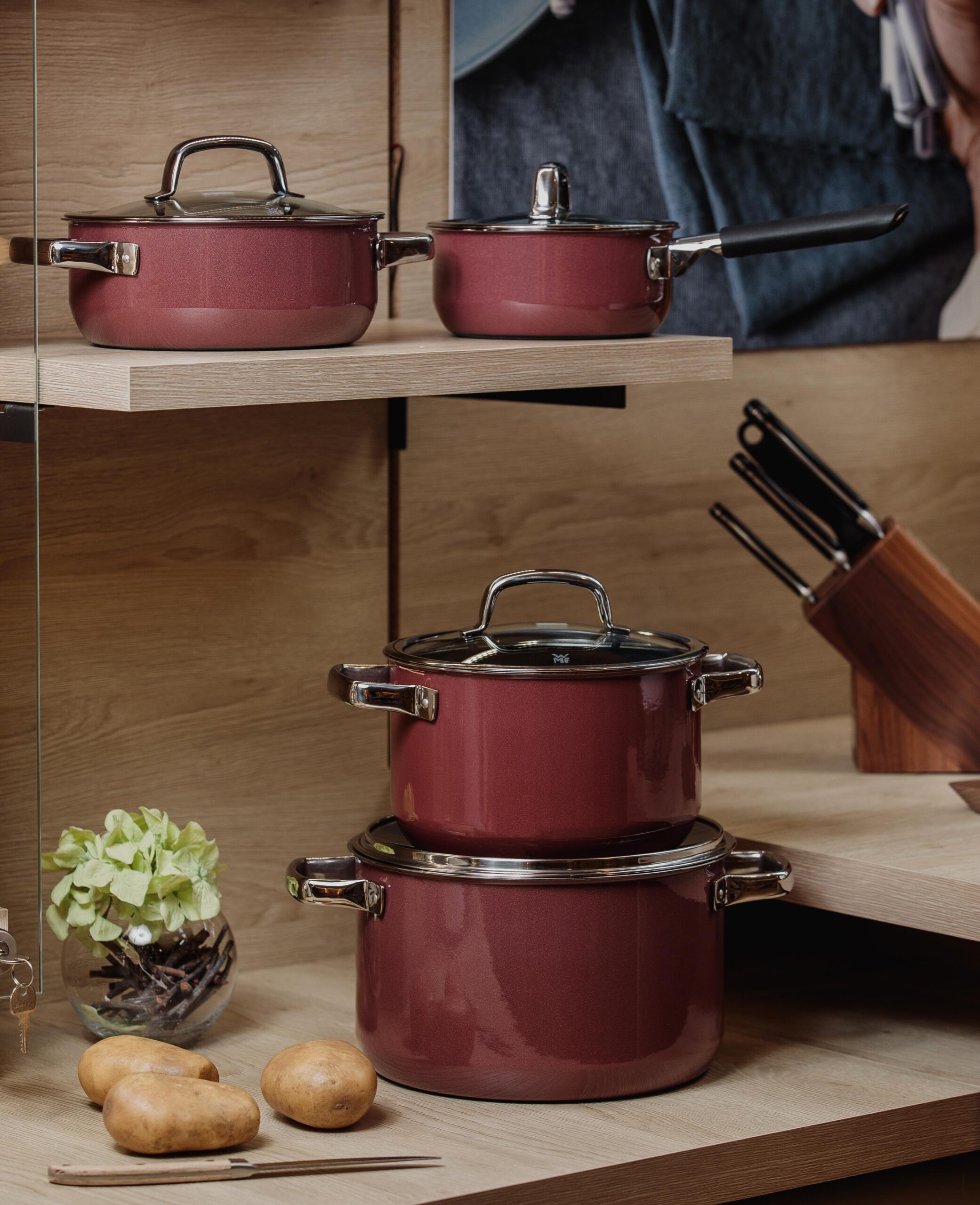
Place a soft cloth between stacked pans to prevent scratches. Hang pans or use a cookware organizer to avoid pressure on coatings.
| Task | Why It Matters |
| Hand wash only | Preserves non-stick coating integrity |
| Avoid abrasive tools | Prevents scratches and coating damage |
| Prevent thermal shock | Avoids cracks in pure ceramic or coating |
| Use silicone/wooden utensils | Keeps surface smooth and non-stick |
Conclusion
When considering ceramic cookware, it’s important to know what to expect. These pans usually do not contain PTFE, PFOA, or other harsh chemicals often found in some non-stick coatings.
Ceramic pans offer a non-stick surface and are easy to clean. However, their coating can wear down over time, especially if you use metal utensils or cook at high heat.
You should watch out for products that are poorly made, as they might contain trace amounts of metals. Always check product labels and buy from trusted suppliers to reduce risks.
Sellers like you can benefit from offering ceramic cookware, since many buyers search for eco-friendly and non-toxic choices. Take time to review what your market needs and compare products side by side:
| Feature | Ceramic Cookware | Traditional Non-Stick |
| PTFE/PFOA Free | Usually Yes | Sometimes |
| High Heat Safe | Sometimes | Rarely |
| Non-Toxic | Yes (quality brands) | Not always |
As a seller, giving your customers clear facts helps build trust and value. If you want to partner with a reliable manufacturer, you can request a quote to explore your options. This way, you can offer quality products and meet the rising demand for safe, modern kitchenware.
Frequently Asked Questions
What are the potential health risks of using scratched ceramic pans?
When you use scratched ceramic pans, the main concern is reduced nonstick performance and possible leaching of metals if the coating wears off. Most ceramic coatings are made to be non-toxic, but if the surface is damaged, it can cause faster wear and make cookware less safe or effective over time. Scratches may also trap food and make cleaning harder, increasing your risk of bacteria growth.
How does the safety of ceramic cookware compare to Teflon-based options?
Many people choose ceramic cookware because it avoids the chemicals found in traditional Teflon coatings, such as PFAS and PFOA. Teflon, when overheated, can give off fumes that may cause flu-like symptoms. Ceramic options are seen as safer for daily cooking because they do not emit those fumes and are free from those chemicals.
Are ceramic coated pans effective in preventing food from sticking?
Ceramic-coated pans work well for nonstick cooking when they are new. They let you cook eggs and pancakes with little or no oil. However, over time, the nonstick layer can lose its strength, especially if you use metal tools or wash the pans in a dishwasher. For best results, use silicone or wooden spatulas and hand wash your pan.
Is ceramic cookware safe for your health?
Ceramic cookware made by reputable brands is considered safe for cooking because it is non-toxic and free of harmful chemicals like lead and cadmium. Always check for safety certifications before you buy a product. If used and cleaned properly, ceramic cookware can be a healthy choice in your kitchen.
